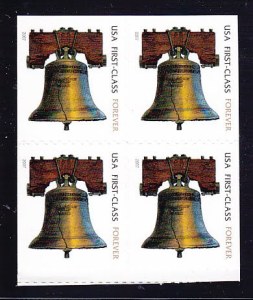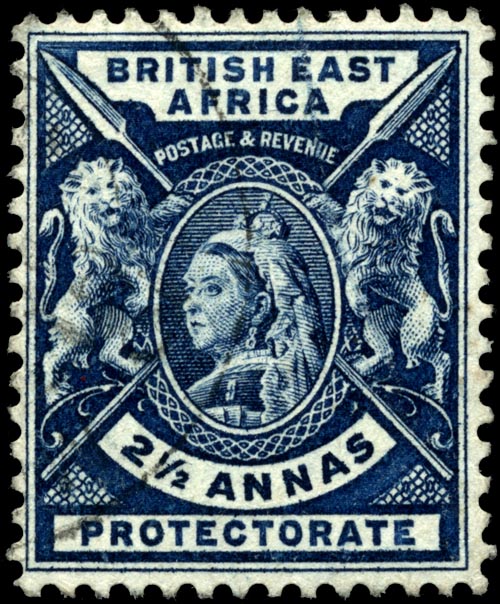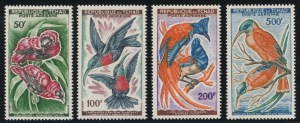 Many collectors spend a great deal of money on their hobby and don't have a great deal to show for it. Your money is yours to do with as you please (after all, this is America), but most people take some satisfaction in getting their money's worth when they buy something and, if not always getting the best of all possible deals, at least getting product commensurate with what they have spent. If you wish to do that, stay away from estate sales. Many of the worst collections and stocks that I have ever seen have been put together at estate sales—where collectors sometimes get good deals but more often compete with other relatively unknowlegeable collectors for overvalued, overgraded stamps.
Many collectors spend a great deal of money on their hobby and don't have a great deal to show for it. Your money is yours to do with as you please (after all, this is America), but most people take some satisfaction in getting their money's worth when they buy something and, if not always getting the best of all possible deals, at least getting product commensurate with what they have spent. If you wish to do that, stay away from estate sales. Many of the worst collections and stocks that I have ever seen have been put together at estate sales—where collectors sometimes get good deals but more often compete with other relatively unknowlegeable collectors for overvalued, overgraded stamps.Monthly Archives: April 2017
- Posted April 28, 2017Read more »
 Many collectors spend a great deal of money on their hobby and don't have a great deal to show for it. Your money is yours to do with as you please (after all, this is America), but most people take some satisfaction in getting their money's worth when they buy something and, if not always getting the best of all possible deals, at least getting product commensurate with what they have spent. If you wish to do that, stay away from estate sales. Many of the worst collections and stocks that I have ever seen have been put together at estate sales—where collectors sometimes get good deals but more often compete with other relatively unknowlegeable collectors for overvalued, overgraded stamps.There are three reasons for this. First, as mentioned, there
Many collectors spend a great deal of money on their hobby and don't have a great deal to show for it. Your money is yours to do with as you please (after all, this is America), but most people take some satisfaction in getting their money's worth when they buy something and, if not always getting the best of all possible deals, at least getting product commensurate with what they have spent. If you wish to do that, stay away from estate sales. Many of the worst collections and stocks that I have ever seen have been put together at estate sales—where collectors sometimes get good deals but more often compete with other relatively unknowlegeable collectors for overvalued, overgraded stamps.There are three reasons for this. First, as mentioned, there - Posted April 27, 2017Read more »
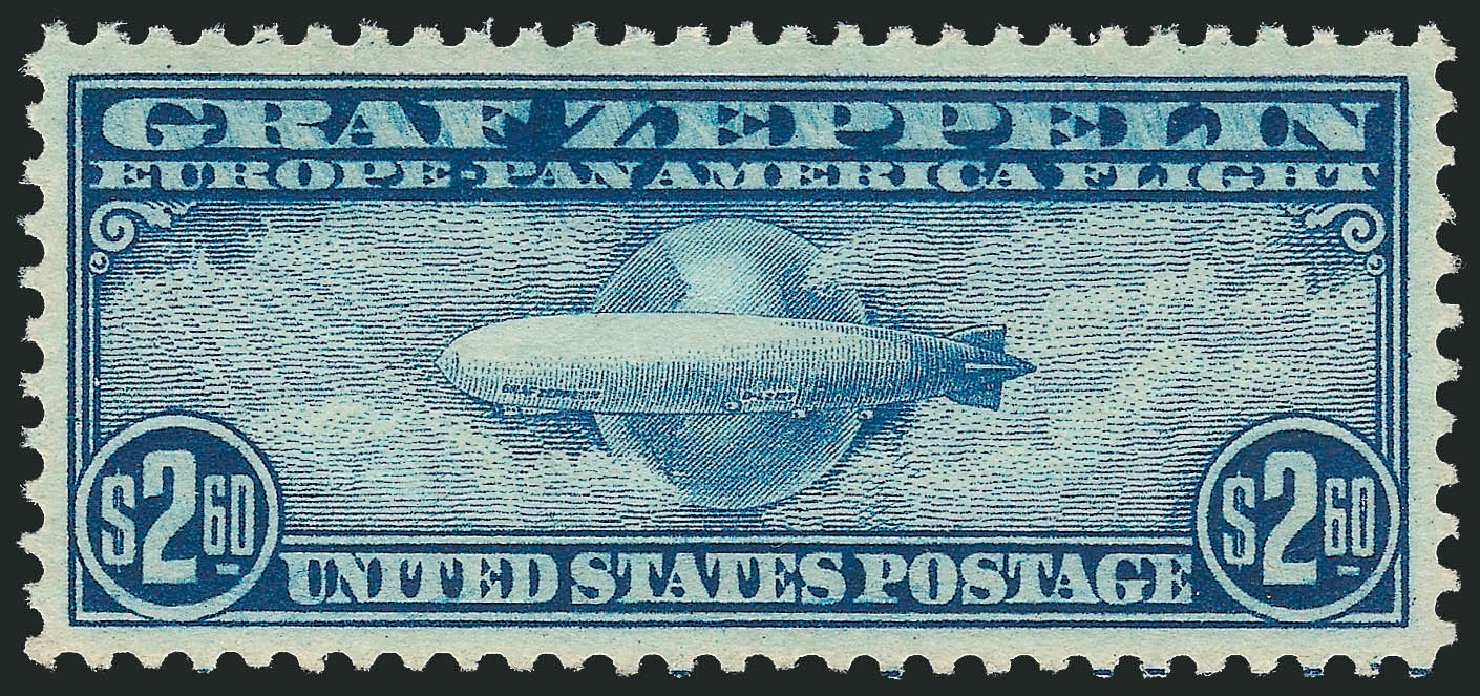 Dave and Jenny were older when I first met them in the early 1970s. My first job at the company was working in the shop (we had one then), and Dave and Jenny were regulars. They had married late, and because of the economic distress of the Depression had put off children until that wasn't a possibility anymore. Like many older, childless couples, they grew closer and even parental and protective towards each other, and I thought they had one of the fondest relationships I had ever seen. They did everything together—even collect stamps. They both collected United States—Dave with a concentration towards US Commemoratives and Jenny with a concentration in Airmails. Dave was proud of his Trans-Mississippis. He lacked only the $1. And Jenny's Zeppelins were complete except for the #C15.
Dave and Jenny were older when I first met them in the early 1970s. My first job at the company was working in the shop (we had one then), and Dave and Jenny were regulars. They had married late, and because of the economic distress of the Depression had put off children until that wasn't a possibility anymore. Like many older, childless couples, they grew closer and even parental and protective towards each other, and I thought they had one of the fondest relationships I had ever seen. They did everything together—even collect stamps. They both collected United States—Dave with a concentration towards US Commemoratives and Jenny with a concentration in Airmails. Dave was proud of his Trans-Mississippis. He lacked only the $1. And Jenny's Zeppelins were complete except for the #C15. - Posted April 25, 2017Read more »
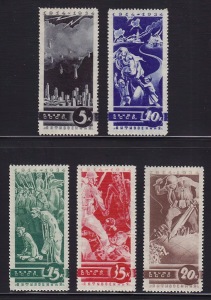 Russian stamps of the 1930s have always fascinated me. They are beautiful and well designed with friendly, internationalist themes, and yet they were issued by a vicious regime that was systematically exploiting its citizens and was highly militaristic in orientation. Another aggressive state of this period, Germany, at least was more honest about its goals and had a highly nationalistic stamp issuing policy. In the exaltation of the Volk and the Fatherland, it's easy to see the factors that led to WWII. But as George Orwell explained so well in Nineteen Eighty-Four, the pathological hypocrisy of the Soviet communist system was without equal in history. Even as he was condemning millions of his own citizens to the Gulag or starvation, Stalin's stamps show kitschy representations of pacifism and coexistence.
Russian stamps of the 1930s have always fascinated me. They are beautiful and well designed with friendly, internationalist themes, and yet they were issued by a vicious regime that was systematically exploiting its citizens and was highly militaristic in orientation. Another aggressive state of this period, Germany, at least was more honest about its goals and had a highly nationalistic stamp issuing policy. In the exaltation of the Volk and the Fatherland, it's easy to see the factors that led to WWII. But as George Orwell explained so well in Nineteen Eighty-Four, the pathological hypocrisy of the Soviet communist system was without equal in history. Even as he was condemning millions of his own citizens to the Gulag or starvation, Stalin's stamps show kitschy representations of pacifism and coexistence. - Posted April 24, 2017Read more »Almost from the very day that Philately began as a serious hobby, stamp collectors were plagued by forgeries. Forgeries exist in two types; those made for philatelic consumption and those produced to defraud the postal service of revenue (called postal forgeries). These postal forgeries are in nearly all cases not only very rare but highly collectible and desired as examples of postal history. But philatelic forgeries are rarely scarce, and seldom desired by stamp collectors. But they do turn up unwanted in many stamp albums and though detailed counterfeit detection is work for experts, there are many things even a casual stamp collector can know that can help spot a forgery or at least arouse suspicion.
- Posted April 21, 2017Read more »There are very few long term savings certificates that are tied to the rate of inflation, but several years ago the United States Post Office effectively issued an even better investment vehicle. With the "First Class Forever" stamps, the Post Office promised completely paid first class postage any time in the future. In 1960, the postage rate was 3¢. According to to Bureau of Labor Statistics, the rate of inflation during that 50 year period from 1960 should have produced a current postage rate of 22¢. So the cost of first class postage has gone up at twice the rate of inflation over the last fifty years.It's anybody's guess whether the cost of first class postage will continue to increase at twice the rate of inflation, but my guess is that it should.
- Posted April 20, 2017Read more »When Rowland Hill invented the postage stamp, an integral part of his design was a "wash of mucilage applied to the back, which, when moistened would allow the stamp to adhere to paper." In the very early years of stamp collecting, collectors primarily collected used stamps. After all, the reasoning went, why spend good money when stamps in the late 1860s was the height of folly? After all, what could they ever be worth?Led by the Belgian stamp dealer Moens, collectors began collecting unused stamps in the 1870s and 1880s. True, they didn't display the purpose for which stamps were invented (that is, postal use), but the collectors didn't have disfiguring cancellations to worry about. So, they pasted the unused stamps in their albums, or if they received stamps
- Posted April 18, 2017Read more »
 Confederate States regular issues consist of fourteen Scott issued stamps that were issued over a period of four years during which the Civil War was fought. There are only two scarce stamps, and both of these issues occurred when the Confederate States Post Office decided to change issues in 1863. The new stamps were originally printed with the denomination in letters rather than in numerals. The history of having the denomination of stamps written in letters rather than numerals is one of generally short issues and low press runs. Postal workers hate them. Post office work has always combined high volume with stress and monotony which can be an unpleasant combination.Not being able to readily determine the denomination on the stamps on the envelopes
Confederate States regular issues consist of fourteen Scott issued stamps that were issued over a period of four years during which the Civil War was fought. There are only two scarce stamps, and both of these issues occurred when the Confederate States Post Office decided to change issues in 1863. The new stamps were originally printed with the denomination in letters rather than in numerals. The history of having the denomination of stamps written in letters rather than numerals is one of generally short issues and low press runs. Postal workers hate them. Post office work has always combined high volume with stress and monotony which can be an unpleasant combination.Not being able to readily determine the denomination on the stamps on the envelopes - Posted April 17, 2017Read more »
 Stamp theft, despite the scare stories that you sometimes hear, is really not much of a problem. We rarely have a customer inform us that his stamps were stolen and the APS's stamp theft committee almost never sends out an advisory of a stolen collection. In the 1970's stamp theft was more of an issue than it is now and the change from stamps being an actively stolen commodity to an infrequently pilfered one tells us a lot about the changes in our hobby and our world in the last thirty years.
Stamp theft, despite the scare stories that you sometimes hear, is really not much of a problem. We rarely have a customer inform us that his stamps were stolen and the APS's stamp theft committee almost never sends out an advisory of a stolen collection. In the 1970's stamp theft was more of an issue than it is now and the change from stamps being an actively stolen commodity to an infrequently pilfered one tells us a lot about the changes in our hobby and our world in the last thirty years.
The reason for the reduction of stamp thefts is threefold. First, stamps have languished in value so that on a "value to difficulty of fencing ratio" they are an inefficient product to steal. High end TVs, computers and jewelry have made much more appealing targets over the last thirty years and stamps that are stolen are often taken as an afterthought of another robbery. Second, most criminals - Posted April 11, 2017Read more »
Africa is a large continent, inhabited by scores of different ethnicities, speaking hundreds of different languages and dialects. By about 1850, partly through the interference of European powers, partly because of the ebb and flow of history (several large and successful African Empires had broken up between 800 and 1600 AD), and partly because climate and language made large scale political unification difficult, Africa had few indigenous political institutions or the military capabilities that would have allowed it to resist European powers bent on colonization. Early European contacts with Africa had been disastrous for Africans. Rapacious slave traders plied African coasts destroying lives and political power centers. And African tribes were encouraged to fight wars to supply European traders with human POWs for export as slaves. By 1850, the period of extensive capture of new slaves in Africa was largely over (worldwide disgust over the evils of slavery had made international slave
- Posted April 11, 2017Read more »
There is no more valuable substance in the world by weight and volume than original gum. Consider—the gum on a thousand mint US Ten Cent 1847's if miraculously removed, commingled and weighed would total about an ounce. And the value of such gum on the stamps is $12,500 for each stamp according to the latest Scott catalog (the difference between an" og" price and a "no gum" price) which makes our magic ounce of og worth a cool $125 million (a US #31 has a $20,000 premium for og making a thousand of them worth $200 million.) And og is increasing rapidly in value. The price of Nineteenth Century stamps with original gum has far outstripped the price of the same stamps without gum over the last twenty years. And this is for a substance that is invisible when you mount your stamps and requires the utmost care so as not to compromise or damage. And that is when you are fortunate enough to have bought og in the first place. I can't tell you how many certificates from
- Posted April 10, 2017Read more »
 Hard as this is to believe, throughout the 1950s, the United States Post Office issued an average of ten stamps per year with a total face value of 30¢. Last year, there were over 150 issues with a $77 face value. When one is tallying up where collector dollars get spent, it is hard to avoid wondering what would happen to the price of older stamps if the USPS (and foreign Post Offices, which are usually not much better, and often much worse) had issuing policies that were more conservative.Over the last twenty years, the United States has issued over 3,500 different stamps with a combined face value of over $1,700. And since most of these stamps are marketed in sheets of twenty, a devoted collector could easily have spent $30,000
Hard as this is to believe, throughout the 1950s, the United States Post Office issued an average of ten stamps per year with a total face value of 30¢. Last year, there were over 150 issues with a $77 face value. When one is tallying up where collector dollars get spent, it is hard to avoid wondering what would happen to the price of older stamps if the USPS (and foreign Post Offices, which are usually not much better, and often much worse) had issuing policies that were more conservative.Over the last twenty years, the United States has issued over 3,500 different stamps with a combined face value of over $1,700. And since most of these stamps are marketed in sheets of twenty, a devoted collector could easily have spent $30,000 - Posted April 07, 2017Read more »One of the most remarkable economic trends of the last several years has been the beginnings of economic growth in sub-Saharan Africa. In the last few years, seven of the twenty countries worldwide
- Posted April 06, 2017Read more »
 A few years ago, I read an article about how smaller town diamond merchants send their stock to each other by ordinary First Class mail. The article said that outside New York, the incidence of First Class mail going astray is nearly nonexistent. Apfelbaum's sends out thousands of packages per year, mostly through the postal service, with almost never a loss. Companies send their valuable packages out Registered or confirmed delivery largely so as to protect themselves from dishonest recipients or doormen who would pretend that the package didn't arrive, rather than because of Postal Service concerns. Think about it; when was the last time you sent a bill or birthday card that didn't arrive?The reason that virtually all First Class letters reach their
A few years ago, I read an article about how smaller town diamond merchants send their stock to each other by ordinary First Class mail. The article said that outside New York, the incidence of First Class mail going astray is nearly nonexistent. Apfelbaum's sends out thousands of packages per year, mostly through the postal service, with almost never a loss. Companies send their valuable packages out Registered or confirmed delivery largely so as to protect themselves from dishonest recipients or doormen who would pretend that the package didn't arrive, rather than because of Postal Service concerns. Think about it; when was the last time you sent a bill or birthday card that didn't arrive?The reason that virtually all First Class letters reach their - Posted April 04, 2017Read more »
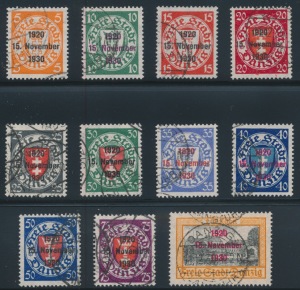 One of the most interesting philatelic areas is Danzig, now called Gedansk. Danzig is a city, or rather City State, on the shores of the Baltic Sea between Germany and Poland (which was long ruled by Russia), and part of its philatelic charm is in the many issues that were created as political control bounced back between various outside nations. For most of the early stamp period, Danzig was part of Germany and used German postage stamps—first the stamps of Prussia, of which it was a part, and then after 1871 and German unification, using the stamps of Germany. After 1920 and the Treaty of Versailles, Danzig was stripped from Germany and became a free city and as such issued its own postage stamps. It is during this period that most collectors know Danzig as the country created several hundred stamp issues. The stamps are for the most part easily obtained in mint condition, but the challenge is finding many of the issues in legitimately used condition and in finding the hundreds
One of the most interesting philatelic areas is Danzig, now called Gedansk. Danzig is a city, or rather City State, on the shores of the Baltic Sea between Germany and Poland (which was long ruled by Russia), and part of its philatelic charm is in the many issues that were created as political control bounced back between various outside nations. For most of the early stamp period, Danzig was part of Germany and used German postage stamps—first the stamps of Prussia, of which it was a part, and then after 1871 and German unification, using the stamps of Germany. After 1920 and the Treaty of Versailles, Danzig was stripped from Germany and became a free city and as such issued its own postage stamps. It is during this period that most collectors know Danzig as the country created several hundred stamp issues. The stamps are for the most part easily obtained in mint condition, but the challenge is finding many of the issues in legitimately used condition and in finding the hundreds - Posted April 03, 2017Read more »
 The Lone Wolf was a detective series in the 1920s about a high end burglar named Michael Lanyard who helped the police solve crimes. The series was written by Louis Joseph Vance and was made into about twenty movies in the 1930s. I happened to see one recently on TCM entitled The Lone Wolf Keeps a Date. The plot is a twisted kidnapping, but a key part of the story is that the Lone Wolf—a cool debonair urbane sophisticated lady killer and international jewel thief and crime solver—is a stamp collector. In the first scene, he buys what appears to be a Cuba #244a, an inverted center (though the denomination was difficult to see, and the movie was in black and white) which is represented as the great rarity that the Lone Wolf needs for his very extensive stamp collection (though the invert today catalogs only $650, so philatelic license was taken as to rarity). The collection is then stolen from the Lone Wolf who must solve the kidnapping
The Lone Wolf was a detective series in the 1920s about a high end burglar named Michael Lanyard who helped the police solve crimes. The series was written by Louis Joseph Vance and was made into about twenty movies in the 1930s. I happened to see one recently on TCM entitled The Lone Wolf Keeps a Date. The plot is a twisted kidnapping, but a key part of the story is that the Lone Wolf—a cool debonair urbane sophisticated lady killer and international jewel thief and crime solver—is a stamp collector. In the first scene, he buys what appears to be a Cuba #244a, an inverted center (though the denomination was difficult to see, and the movie was in black and white) which is represented as the great rarity that the Lone Wolf needs for his very extensive stamp collection (though the invert today catalogs only $650, so philatelic license was taken as to rarity). The collection is then stolen from the Lone Wolf who must solve the kidnapping



